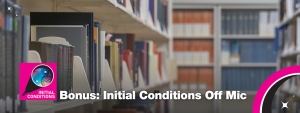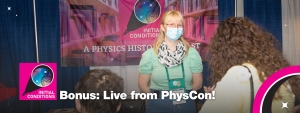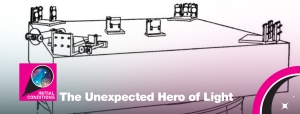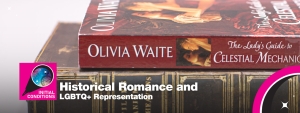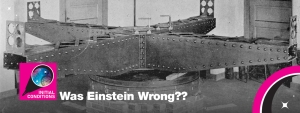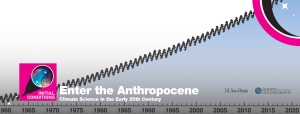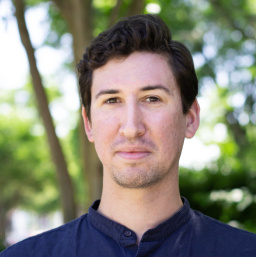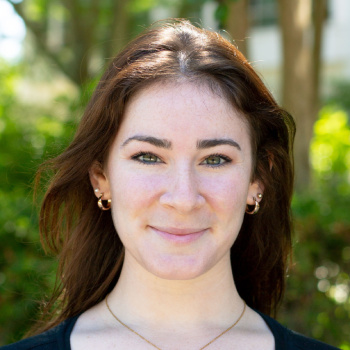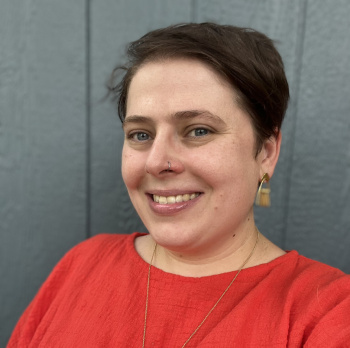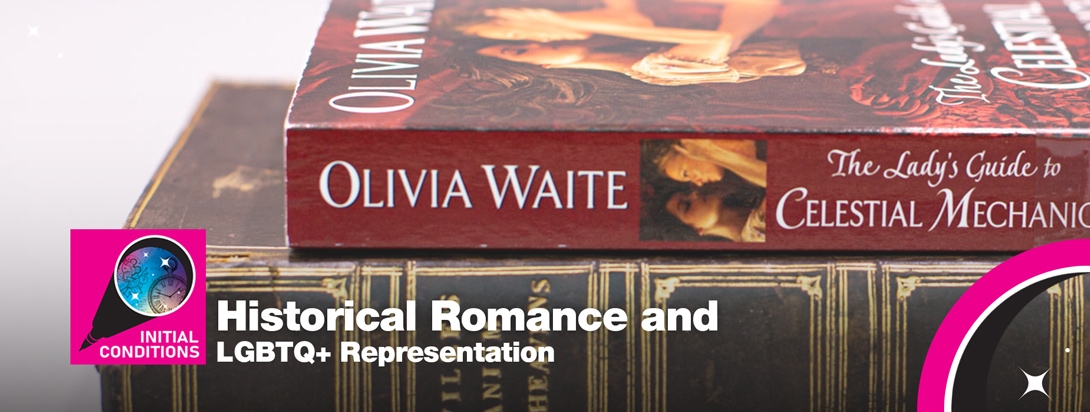
The Ladies Guide and Mechanism of the Heavens
This episode will tell the stories of Caroline Herschel and Mary Somerville. It features an interview with Olivia Waite, who combines the two historic women in the protagonist of her regency, sapphic, romance novel The Lady’s Guide to Celestial Mechanics. Caroline Herschel was the first woman to discover a comet and artfully navigated the scientific world of the 18th and early 19th century to become one of the first paid women astronomers. Mary Somerville was potentially the most successful scientific writer of all time. Self-taught and charming, she grasped complex concepts in all physical sciences and communicated them to the world in her many books.
But learning about the lives of these scientific women does not provide understanding of what their lives felt like. Often, women who contributed to science are left out of history or parts of their identity have been erased. To rectify this gap in the traditional historical narrative, historical fiction and romance writers depict vivid and realistic stories of the lives that rarely make history books. In her interview, Olivia Waite shares how she researches and writes historical romance and the importance of this genre to showcase LGBTQ+ identities.
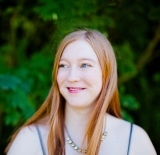
Olivia Waite writes fantasy, science fiction, and historical romance and is a romance columnist for the New York Times Book Review.
Speakers: Maura Shapiro and Justin Shapiro
Initial Conditions Episode 6: Historical Romance Date: August 17, 2022
MAURA: So Allison, you're holding a very small book.
ALLISON: It is a romance novel.
MAURA: And why does the science library have a romance novel?
ALLISON: Well, I must admit I was reading it in my own personal time. It was recommended to me by some friends. And as I was reading it, I realized it had great relevance to our collection because it imagines a world in which women of the 18th and early 19th century are doing science and what that would be like for them. It also imagines sort of like what it would take to publish their works, to get credit, what their lives were like. Which is not information that is in the history books.
MAURA: That's Allison Rein, associate director of library collections and services here at the Niels Bohr Library and Archives
JUSTIN: The book we're looking at is The Lady's Guide to Celestial Mechanics by Olivia Waite. It's a small paperback, and on the cover is a picture of two women dressed in period clothes in a passionate embrace. It's not the kind of book you might imagine could live in this collection.
MAURA: But, as we'll hear in this episode, there's a very good reason it does.
ALLISON: If we do have the records of female scientists, they are not leaving us with sort of their own perspective of how hard it was to work at that time. And I thought that fiction can actually do a great job of filling in the lines of history, especially for people that are not as well-documented. And it reminded me of some books that we have in our rare book collection.
JUSTIN: The Lady's Guide is loosely based on the lives of two women scientists, whose biographies and letters and work live in our collection. Mary Somerville and Caroline Herschel. Fortunately, they both have a lot written about them, including their own accounts.
MAURA: But it's hard to know what their lives were really like, so we've turned to this novel that provides a kind of realistic example of what it could have felt like to be a woman scientist in the 19th century. And that is the beauty of historical fiction.
ALLISON: We know it's not history, we cannot claim that this is true, but it could be true, and it sort of shows us what it might have been like for some of the names of scientists that we lost and didn't get any credit, but if we have, you know, two that we know of, what are the many dozens or hundreds who just disappeared? And what their lives might have been like?
MAURA: This is Initial Conditions, a physics history podcast.
JUSTIN: Every physics problem begins with a set of initial conditions that provide the context for physics to happen.
MAURA: Likewise, in Initial Conditions, we'll provide the context in which physical discoveries happen. We'll dive into the history behind the science of people, places, and events that have been overlooked and largely forgotten.
JUSTIN: And today we're going to tell a story that is often left out of the history books: the story of two women scientists of the late 18th and 19th centuries.
MAURA: Justin, this episode today is a little bit different than our episodes in the past. So our initial conditions for today are a little bit tricky. But we're still going to do them because they're fun. So the initial conditions for today's episode, one is inspiring women in science history. Two, which is kind of a less positive note, is the erasure of LGBTQ+ figures in history. And three, I'm not actually sure what I want the third initial condition to be. Justin, what do you think?
JUSTIN: Well, you've been telling me about this episode for a while, Maura, and it sounds to me like maybe our third initial condition could be, how about, moments of resistance to male-dominated science in the 18th century? So we're talking in the 1700s.
MAURA: Yeah, and I'm glad you cleared that up, because I still get the 1700s vs the 17th century incorrect. Yeah, sounds good. Okay so as we know, a goal of this podcast is to showcase stories of physics that have traditionally been left out of the historical narrative. The difficulty is that because they've been left out of the historical narrative, it's hard to resurrect them.
JUSTIN: Right. For example, we may not have the details of the projects that women worked on, records of their correspondence, photographs, or even many clues into their lives.
MAURA: But they did exist, and telling the history of science would be incomplete without including them. One way to rectify the lack of representation is through historical fiction. Writers can create characters that would have lived vibrant and full lives and contributed to science in a realistic way.
JUSTIN: Historical Friction would have been a good name for the podcast.
MAURA: (laughs)
JUSTIN: Historical fiction can allow us to think about the past in ways that might not be fully captured by historical records.
MAURA: Historical romance also does this, but it goes a step further, adding another dimension to history: love.
JUSTIN: The love dimension.
MAURA: (laughs) The fifth dimension, love. It might be easy to reflect on the past and past scientific figures, only in the terms of the science they produced. But romance is about love, obviously, and it humanizes these figures. Through historical romance, readers can live in the past and learn not just the facts of history, but what history feels like.
JUSTIN: It's immersive, and it's supposed to be immersive.
MAURA: Today, we'll talk about two important women scientists of the late 18th and early 19th centuries, and interview Olivia Waite, the author who brings their era to life in The Lady's Guide to Celestial Mechanics, published in 2019. Lady's Guide is the love story of two women in the Regency era during the second decade of the 19th century.
JUSTIN: And for all you Kubrick heads out there, Barry Lyndon takes place in the era just before the Regency era. Also during the reign of King George III. As I understand it, the main character, Lucy Muchelney, is loosely based on a combination of Caroline Herschel, one of the most famous astronomers of her time, and Mary Somerville, one of the most important science writers.
MAURA: Before we talk with the author, Olivia Waite, let's talk a little bit about who these women were. And just to emphasize the importance of these women, they were inducted as honorary members of the Royal Astronomical Society in 1835. That's over 80 years before the Royal Astronomical Society officially accepted women members, which is I guess a commentary both on them and on the Royal Astronomical Society.
JUSTIN: Women have always participated in science, often working behind the scenes or alongside their male partners and relatives, receiving little acknowledgment. So for both women to have been celebrated in this context is an outstanding achievement.
MAURA: Exactly. Let's talk about these women one at a time and then dive into our conversation with Olivia Waite.
JUSTIN: Okay, tell me about Caroline Herschel.
MAURA: Okay, if you were to ask young Caroline Herschel if she thought she would grow up to be one of the most important astronomers of her time, she probably would have politely blushed and denied it. And then she would probably write very humbly in her diary about how all she cared about was helping her family. And she might have even mocked you for being a gossip.
JUSTIN: Well what was she known for?
MAURA: Caroline Herschel was the first woman on record to discover a comet. In fact, she held the record for number of comets discovered by a woman for almost a century. But potentially, her most important contribution is her revision to the Flamsteed Star Catalogue, which was basically the standard celestial catalogue at the time. And through carefully reorganizing it, she found some stars had been double-counted in the original catalogue, and others not at all. Her edition was huge and widely celebrated.
JUSTIN: How did she achieve this?
MAURA: Well, she was born in 1750 to a poor family in Hannover, Prussia. Which although today would be in Germany, it had strong ties to England. And she describes her ascent to fame as kind of a Cinderella story. And that's potentially because later in her life, the Brothers Grimm were very popular, but also likely because it's a story that enables female achievement in a very passive and what would have been seen as "feminine" way. So it enables her to succeed but kind of as a woman. But you get the sense, though, because Caroline kept journals, that she had a lot of agency, and she was very bright and knew how to get the recognition for her achievements when many women didn't. But she did have a rocky start. She was a very sickly child. She had small pox at age six, which permanently scarred her, and she got typhoid at age ten, which permanently stunted her growth. As a full-grown adult, she only reached 4'3".
JUSTIN: That's pretty short.
MAURA: Yeah, that's what? Half your height?
JUSTIN: Yeah, I'm 8'6".
MAURA: (laughs) Maybe not that tall, but yeah, that's very short. Like many children of her time and in her area, Caroline received an elementary education. And in her free time, she took additional courses in domestic skills like sewing and cooking. And she was very devoted to her family. She always put them first. And everything she did was for the betterment of her family. She actually came into astronomy, not because of her own passions or desires for learning, but because her brother William required an assistant. William Herschel, and another brother Alexander, had moved to London to establish careers as musicians. But William was enamored with astronomy and he led Caroline and Alexander to join his telescope-making business.
JUSTIN: This turned out to be the right career choice for him. In 1781, he discovered a new planet, later named Uranus, which of course brought fame to him and his telescopes.
MAURA: Caroline was his dutiful assistant as he methodically observed the night sky for celestial objects like nebulae, comets, double stars, and star clusters. He would call out their positions and she would record them. During the day, they would calculate orbits and she would study astronomy to better herself as an assistant. It wasn't clear that she really even liked astronomy or math, but quickly picked up the skills and eventually grew to like it. She observed on her own when time permitted, and discovered her first comet in 1786. The first discovered by a woman. She went on to find seven more, six of which she had priority to. And over the next ten years, her fame grew and most in astronomy really respected her talents as an astronomer.
JUSTIN: So it sounds like the comet discovery field was pretty competitive at this point in the late 18th century.
MAURA: It was. She had been beaten to discoveries in the past, so her last comet discovery was an incredibly dramatic encounter. She was up at night observing--
JUSTIN: As astronomers do.
MAURA: Exactly. And she found this comet. Not wanting to be beaten to the discovery, as she had in the past, she didn't want to rely on letters to announce her discovery. So instead, she got on a horse-- in the middle of the night, got on a horse, and rode 30 miles to Greenwich Observatory to announce the discovery herself to her friend Nevil Maskelyne, who was the Royal Astronomer. And this was an incredible feat, because she rarely left her own home, didn't go more than a mile or two away, and there she is, middle of the night, this 4' tall woman riding to assert her dominance in discovering this comet.
JUSTIN: And despite the difficulty of her journey, it's a good thing that she made it. Her instinct to leave quickly was vindicated because while she was recuperating at Maskelyne's place, he received another letter announcing the discovery of the same comet sent the same day as her.
MAURA: Exactly. You get the sense that she was grumpy and self-sacrificing. Definitely not social. She thought poorly of most women in society and had very few close friends. Still, she had ambition, and fortunately, a brother who supported it. She also had the political sense to announce her discoveries in a way that wouldn't threaten men of science. She lived to be 97 and was mounted with accolades. She took care of her family and helped raise her nephew, William's son, John Herschel. And nurtured in him a love of astronomy and a respect for women in science.
JUSTIN: Caroline Herschel's life reflects many of the currents of science in the late 18th century. The deep scientific connections between Hannover in Germany and England. The refinement of the telescope and all of its mirrors and lenses. And the relative slowness, compared to now at least, of scientific communication. The way that Herschel practiced her science was no different than the way that the leading male scientists of the day did. So that's Caroline Herschel. Maura, what can you tell me about Mary Somerville?
MAURA: All right, so Mary Somerville is pretty different from Caroline Herschel. Mary Somerville seems like one of those people who can do it all, have it all. She was beautiful, she was social, everyone wanted to dance with her. She was talented at piano and sewing and painting. And of course, she was incredibly bright. Probably because she was so well-rounded, people overlooked "eccentricities." Her turn for learning, but also her liberal politics. Her views about slavery, religion, women's rights, and animal rights.
JUSTIN: And just for context, men and women in the 18th and 19th centuries had different social and gender expectations than many places today. So women like Herschel and Somerville had to maintain their traditionally feminine roles while trying to operate in a more masculine sphere. Caroline assisted her brother in order to be a published astronomer, and presented herself in her writing as sort of meek and passive. Mary, on the other hand, proudly showed off her talents, which allowed her to operate more freely in traditionally-masculine occupations.
MAURA: Yeah and Mary wasn't only different from other women of her time. She was exceptional compared to other people of her time. The term "scientist" was first used in order to describe her in a review of one of her books. Her claim to fame was her translation of Pierre-Simon Laplace's "Traité de Mécanique Céleste," from now on I'm calling it Mécanique Céleste, and you'll have to deal with my bad French. But Mary Somerville was a prolific science writer. She published multiple noteworthy books, many of which were used as college textbooks. She was born Mary Fairfax the day after Christmas in 1780 in Scotland to an aristocratic but not exceedingly wealthy family. She taught herself mostly, by exploring and collecting specimens, reading books, even translating a text from French despite not knowing the language.
JUSTIN: Well how did she do that?
MAURA: Well she simply used a French dictionary. But, as I'm sure you've picked up by now, she eventually learned to speak French fairly well.
JUSTIN: Yes, that does seem like foreshadowing. Did she receive any formal education?
MAURA: She went to school for one year, around age nine or ten, because her father thought it would help with her marriage prospects. But she hated school and cried every day. It turns out she did not need school to learn because she was fervent about her own learning, to the point where most of the family thought she was odd and her dad, again, worried about her marriage prospects. She only really had the full support of her uncle, Doctor Somerville.
JUSTIN: Had she always been interested in math and physics?
MAURA: Not specifically, but she had always been curious about the world around her. When she was a teenager, however, a friend showed her a women's magazine with an algebra puzzle in it. She'd never seen algebra before and wanted to know more, but she had no idea where to look and neither did anyone else in her life, really. She eventually found the answer during a painting lesson when an instructor mentioned Euclid's geometry. And her life sort of took off from there. She stayed up all night reading Euclid and after she used up all of the family's candles, she performed calculations from memory in the dark.
JUSTIN: Wow, I can hardly perform calculations on paper in the light.
MAURA: (both laugh) She is truly impressive. And it turns out, her dad did not need to worry about her marriage prospects. She married twice. The first was to Samuel Greig in 1804, who disapproved of her love of learning. But, I hate to say, luckily he died three years later, and with his money and the freedom of being a widow, she was able to spend all her time learning. Her second husband was quite different. William Somerville was the son of her most supportive uncle, and he championed her. He actually acted like many of the scientific wives did, doing the copying and the tedious work so Mary Somerville could commit full-time to science. He was also her ticket to scientific societies that she couldn't attend because of her gender.
JUSTIN: William was her ticket in, but she had no trouble gaining the admiration of many prominent scientists.
MAURA: That's right. She established a deep friendship with John Herschel, Caroline Herschel's nephew, who grew into an astronomer and mathematician. Somerville also became very close to Charles Babbage, who was working on a calculating machine, and she mentored Ada Lovelace, who would go on to write a theoretical program for Babbage's calculating machine, making Lovelace the first ever computer programmer. Pierre-Simon Laplace was rumored to have said that Mary Somerville was one of three women in the world who could understand his text. The other two were Mary Grieg and Mary Fairfax, which of course are her other names. And this fable is told in many different ways, so probably he didn't say that, but in 1827, Lord Henry Brougham, representing-- this is kind of a mouthful-- the Society for the Useful Distribution of Knowledge (Correction--Society for the Diffusion of Useful Knowledge), wrote to William requesting Mary's services. They wanted a translation of Laplace's Mécanique Céleste.
JUSTIN: Mécanique Céleste is a five-volume treatise on celestial mechanics. Shocking. The five volumes comprising the original edition were published between 1798 and 1825. Laplace's goal was to unite all the physical theories under one mechanistic story. In some ways, Laplace finished what Newton and a long line of physical theorists had started, using complex yet elegant mathematics.
MAURA: Brougham said basically, if Mary Somerville can't do it, nobody can. And understanding the delicate nature of asking a woman for a scientific work, he assured her that no one will know who wrote it. After much persuasion, Mary begrudgingly agreed to do it, with the promise to burn the manuscript if it was a failure. But it wasn't easy to do this complex translation and keep it a secret. She wrote about how difficult it was as a woman to work, because she would get up early, do all her household tasks, take care of her family, teach her children for a few hours a day, play piano for a few hours, just to have time in the afternoon to write and she was constantly interrupted by friends and acquaintances who traveled to see her, and that would also take up hours of her time. She said, basically, that men could just say, "Sorry, I'm working." But as a woman, working in secret, she couldn't. She decided to expand on Laplace's work, adding narrative, explanations, and more details to make it accessible to a broader audience. When she finished the manuscript four years later, Brougham deemed it too long. John Herschel, however, insisted that it had to be published. Mechanism of the Heavens, as she titled it, was printed in 1831, and escaped would have been a fiery fate. Indeed, it was received with great praise. Many hundreds of copies were easily sold, and she was elected as an honorary member for the Royal Astronomical Society alongside Caroline Herschel.
JUSTIN: Wow, that's quite an accomplishment. Did she do anything else?
MAURA: Yes, she went on to have a very prolific science writing career. In 1834, she published Connection of the Physical Sciences, which covered scientific discoveries in fields spanning astronomy, physics, geography, and meteorology. This, like her earlier work, was a huge success, and she continued to release a total of seven editions. She claimed, "I wrote because it was impossible for me to be idle." Her 1836 edition of Physical Sciences included her calculations on the orbit of the newest planet, Uranus, and found it inconsistent with what the numbers should have been. She theorized another unknown planet could have affected Uranus's orbit. One of her readers, John Couch Adams, mathematically predicted the orbit of Neptune. Controversy ensued as to who discovered Neptune, because Adams did not observe it himself, while many other people had likely observed the planet without knowing it.
JUSTIN: John Couch Adams also invented the couch, which is why we call it that. (joking)
MAURA: (laughs) And "atoms." (pronounced Adams.)
JUSTIN: 65 years after Caroline undoubtedly helped her brother discover Uranus, Mary helped in the discovery of Neptune.
MAURA: She also wrote nine editions of Physical Geography, which detailed advancements in geosciences. For example, understanding that the age of the Earth is much older than previously thought. Or, than the bible says. She wrote molecular and microscopic science, and after much begging, she also wrote a personal biography. She wrote up until her death at age 91. Still, she considered herself a failure for never having done her own successful experiments.
JUSTIN: So these were two women, quite different in mannerism and demeanor, who found ways to contribute to astronomy. Men long claimed credit in the field of astronomy, but for the discoveries of Uranus and Neptune, Herschel and Somerville gained recognition where women's labor was usually overlooked. And this happened in the 18th and 19th centuries. It makes you think about what other stories of discovery are waiting to be told.
MAURA: Elegantly put, Justin. So as fun as it was for me to talk about these two women, I'm really excited about this next part of this episode, a conversation with Olivia Waite. In 2019, she published The Lady's Guide to Celestial Mechanics. As I mentioned earlier, Lady's Guide takes place during the Regency era in England, so think Jane Austin, Bridgerton era.
JUSTIN: Or, after the Barry Lyndon era. The story follows Lucy Muchelney's journey to translate Oléron's Mécanique Céleste, which is an allusion to Mary Somerville's translation of Pierre-Simon Laplace's Traité de Mécanique Céleste. It also follows the romance between Lucy and her patron, Lady Catherine [St] Day, the widow of the Count of Moth.
MAURA: Along with Lucy's path to the translation and the hurdles of the patriarchy she must overcome, it's also a story about Catherine exploring her sexual identity. Catherine even learns that her mother had been in a secret love affair with her mother's so-called best friend, her Aunt Kilmarsh.
JUSTIN: This book has wonderful historical details, and once you're familiar with the characters of the time, it's really fun to identify them in her story.
MAURA: Her story also stresses the importance of women's roles in science that were often overlooked. The importance of art and embroidery, and the LGBTQ+ representation that science history currently lacks. Let's get into the interview.
MAURA: So I think a good place to start would be for you to introduce yourself and maybe talk about The Lady's Guide to Celestial Mechanics.
OLIVIA: All right, well, I am Olivia Waite. I write queer historical romance as well as sci fi, fantasy, and critical essays. I'm the New York Times romance fiction columnist at the moment, which is great fun. I started writing Lady's Guide when I had just come out as bisexual. It was right after the Trump election. I had just finished a big manuscript. I was in kind of a slump. My old publisher had closed, I was looking for something new. I sent off this manuscript I'd just finished. Very dark, very weird. And I thought, "Well, what am I going to write now?" And I wanted to write something that was just for me. I was reviewing for the Seattle Review of Books at the time, and what I'd really wanted was a sparkly, Avon-style historical starring two women, because I just couldn't seem to find anything that really scratched that itch. I found a few queer historicals for women, but just nothing was really hitting that sweet spot for me, and I thought, "Well, you know, let me just work on this for fun until something marketable comes along." (laughs) At the time, the rule was that F/F romance didn't sell. That everybody wanted M/M instead.
MAURA: Yes, so for people who don't know, F/F romance is when the two love interests are women, and M/M is when they're both men.
OLIVIA: Mmhmm. So I started writing this fun little manuscript. Because it was just for me, I decided as well as queer women, I was going to put in astronomy and I was going to put in embroidery and I was going to put in botany and scientists and just have a ton of fun with it. I was going to describe everything I'd always wanted to describe and it turned out all of those were excellent decisions, and I sold that manuscript before it was finished. (laughs)
MAURA: Oh wow.
OLIVIA: As part a three-book deal. So yeah, it was a great time. It was really fun. It was the springboard into a whole new world of writing for me. Not just because of the queer women, but because the describing things actually was really helpful. Yeah. And I'd gotten my JSTOR subscription back, so the research depth I was able to do was much better than just scrolling around on the internet, and that also helped. I could find really precise examples from history, and I could find really good analysis of social movements in scientific history, and it all kind of flowed into the book.
JUSTIN: So listening to you speak, it sounds like your interests are very diverse, ranging from science fiction to manners of the Regency period to physics to even technologies of correspondence. And I think you see that reflected in the characters in The Lady's Guide. Everything from botany to astronomy to the technology behind many discoveries of that period. And I was wondering if you could speak a bit about your research methods?
OLIVIA: Ah, well, I tend to follow my instincts. I'm not as thorough. I know people who, once they decide on a topic, they will read literally every book the library has on it. And I just don't really have the patience for that. Which is probably part of why I'm a writer and not a scientist. But for me, research tends to be long. It tends to happen over sometimes years, maybe even decades, but a lot of it is about following instincts and finding the points that spark something. Whether that's-- it could be the driest academic article, but they'll make an aside or a parenthetical, and I will go, "There! That's it." Sometimes it's finding a really great piece of narrative non-fiction that I can kind of use as a structure? So for Waspish Widows, which is the sequel to Lady's Guide, it's all about-- It's about a beekeeper and an engraver who fall in love in a small town during the Queen Caroline affair, which is George III's wife and the big process of their attempt at a divorce through an act of Parliament. And there was this wonderful book about the whole thing, by an author whose name unfortunately I do not have on the tip of my brain. And so I took the timeline that she used in that book and borrowed little sections and wove a plot in between. Which is very different than what I did with Lady's Guide. Lady's Guide, I took all of my favorite people from history. I took Joseph Banks and Humphry Davy and Mary Somerville and a little bit of Caroline Herschel and her brother, and I kind of did versions of them. So a version of Charles Babbage is hanging around as well. And all of their stuff. And so I said, "Okay, well here are all of these people who existed." And I built a plot that had them all interact. With Waspish Widows, it was much more establishing kind of points in time and building a plot like a ribbon between those real points in history. It was a slightly different approach. And it was really fun to do. And so I think the research changes a little with every book because the needs of each book are slightly different. I do tend to like to do hands-on research. For Waspish Widows, I actually went to a local stationer that I know, and she had a letterpress. And so I paid her for an hour to kind of just let me help out and learn the process. The smell of the ink, the feel of the wheel under your hands, the weight of it. All that stuff. It doesn't take much time to get a real sense. You can ask questions about what's it like to do this for months? What's it like to do this on your own or with other people in the shop? The hands-on stuff lets you get details that you don't necessarily find by reading. But also talking to the experts is often better than trying to become an expert in every subject. So it's, I would say my research approach is mixed, eclectic, and yeah, it tends to be a lot of fun as well. I'm a huge nerd and this means I get to explore a lot of different topics and hands-on stuff.
MAURA: I think in The Lady's Guide, I learned a lot about embroidery, which is not necessarily what I expected to. Did you learn how to embroider in the process of writing the story?
OLIVIA: Yes, I had done some sewing before, but I saw a poster. We moved into a new building, and they had a poster in the lobby that was a big print of a patch, and it was like a camping lantern. And somebody had stitched it in just really broad cotton, but it looked very painterly and I was like, "God, that looks so beautiful. The gradation of color that you can get with just a few simple stitches." And I'm like, "I want to try that again." And I had read so many Regency romances with heroines who hated embroidery. It was this stock way to say, "My heroine wants more than domesticity." And that's, you know, it kind of cast domesticity as embarrassing and it's a very "not like other girls" kind of sentiment. Which tends to play into histories of science as well. You've got this idea that, oh, but it's a masculine pursuit, therefore it's better. As opposed to, well, of course, women can do science. We're people. People do science. And so adding embroidery to a science-themed romance really kind of opened up a new avenue that doesn't get explored in a lot of arcs. Where it's about feminine work and craft being devalued whether inside of a masculine-coded profession, the way that science was at the time. But we also got this whole other aspect where the work that women actually are best at, that mostly is done by women, is also undervalued. So things like sewing, knitting, stitching, all those good fiber crafts that tend to dissolve before museums could get their hands on them.
MAURA: Right, and that also leads me to something else I really liked about the story, which it really emphasized how many women were involved in science and just were not getting recognition. So you have the scene at the Polite Science Society, which is the society of men doing science, but in reality, women are there contributing ideas, taking notes, and are just being blatantly ignored.
OLIVIA: Mmmhmm. And that was based on the uncovering that a lot of other writers and scientists had done about, you know, the husbands who always thanked their wives for, "typing up the manuscript," but you know they're checking conclusions and you know they're editing prose and that's not insignificant labor.
MAURA: And sometimes outright doing calculations for them.
OLIVIA: Yes.
MAURA: So yeah, and what I think makes Mary Somerville such an interesting person, is her husband was actually doing all of those (OLIVIA: Right!) editing and copying and he was happily supporting her in her work.
OLIVIA: Yeah, he just thought she was neat. He's like, "Oh, yeah, let's see how far and how smart you can get if you have somebody to take up that slack on the other side."
MAURA: Yeah, and it's sort of like the counter-argument that I never thought we could have is, if women were treated like men, how successful could they have been? It's like, well...
OLIVIA: Exactly.
MAURA: We know. (laughs) She was pretty successful. So what, reading this, I read your book twice. The first time I knew very little about this era in science history, and then I did a bunch of research, learned about Mary and Caroline and then I got all these really amazing nuggets of references to history and science. I particularly loved the representation of Charles Babbage, (OLIVIA: Oh yes.) who invented the first calculating machine. So do you want to talk a little bit about how you chose what to include from history, and how to combine that into your story?
OLIVIA: Well, for me, it does feel very personal. I want to include the things that, like I say, that cause a spark, that get me excited, that kind of light me up. As a writer and as someone with an imagination. So Charles Babbage is interesting, not just because he did something really incredible, but because he was-- he could have done even more if it was actually possible to do it in the time that he was working. He had all these visions for how this machine could function, but they couldn't actually make the parts precise enough. He was just so brilliant and such a unique mind. And the way that famously, Ada Lovelace was making notes on this machine and basically writing the first computer program before the first computer had even been invented. Ada Lovelace, of course, was tutored by Mary Somerville, which was, again, one of the great things that I got to weave in there.
MAURA: So I'm curious, when you wrote The Lady's Guide, did it help you discover your own identity as well?
OLIVIA: Absolutely, yes. I mean, I discovered my bisexuality through reading a romance with a queer heroine. And it was kind of like... it was very much this mirror moment like, "Oh! Oh, this is...this looks like me. This sounds like me. This feels familiar." As opposed to some of the lesbian romances that I'd read before, which were very much like, "Oh, I've always liked girls, I've never liked men. Etc etc." Which was not really my experience. This was more a late in life realization, that, "Oh, and also this." And yeah, I'm a very picky person when it comes to romance and dating, so I like to say it just took 35 years for the evidence to accumulate.
MAURA: (laughs) Also a scientist.
OLIVIA: Oh very much, yeah. (laughs)
MAURA: So that makes sense, because one of the main characters in the story, the love interest, also kind of found her sexual identity through science and after a marriage. So do you want to talk a little bit about the characters in your story? And where the inspiration drew from?
OLIVIA: Well, Catherine is very personal to me. Because I wanted to write that experience of realizing quite late in life, after other relationships, that there was this, not necessarily a rewriting, but the way I describe it in the book is, it's based on how they used to write letters at the time, because paper was expensive, so if you were mailing somebody a letter, you would write the lines in one direction, and then you would turn the paper and write crossways, like not over the other ink, but across the lines of space so you could actually fill a page really densely, but it would still be legible because you would only read the letters that were going in one direction. And so for Catherine, it was like she'd been writing the story of her life, and then this turned it and she saw a whole other story was already there. And that's a little bit what it felt like for me. I was married at the time I came out. I was married to the man I'm still married to. But it was really important to me to engage with this aspect of my identity that I'd been kind of squashing down and shutting up for so long. And Catherine, and Lucy as well, were ways of exploring that without having to actually, god help us, date? Which I didn't want to do. (both laugh)
MAURA: Right. And now it's a resource that other people can relate to and read and see themselves in, which is a really beautiful way to pay it forward as well.
OLIVIA: And that's something that happens, if you've talked to other people who have written all kinds of coming out narratives, whether queer or trans or anything in between, you hear them talk about the people who come out to them as a result of reading this. People write to me to say, "Oh my gosh, Lady's Guide is what I've been looking for. I really respond to this character or the other character." I know other queer authors have had this happen. It's very much something that people really are hungry for. And it wasn't just-- so it's really nice, because it was something that I thought I was doing for myself, but it's something that's giving back to the community that I didn't know was out there from the start. Which is really kind of magical.
MAURA: Something I want to make sure we talk about, because it's really important to me with this book and with the genre in general, is how historical fiction and romance helps the problem of representation in history, because often history books leave out, excludes certain people.
OLIVIA: Sometimes the imagination is the best way we have of connecting with a past that we don't have access to. So you read about people in history, you show them as people, you invite people into this world, and they start to think more things are possible than what they've been allowed, than what they've been shown. I was learning a lot from Black historical romance writers in particular. Beverly Jenkins and Alyssa Cole, who do deep dives-- Vanessa Riley-- very thorough, incredible-- Piper Huguley as well. Are doing absolutely necessary historical research. They add bibliographies to their books so you know exactly where they're getting their source material. And it's about doing something to help heal the wounds of the past. This idea that a lost history creates a lacuna or a gap or a wound that needs to be tended. And so with queer history, we have a lot of those similar erasures. We have information that's been destroyed or suppressed. Letters that have been burned. (laughs) The, you know, the practice of burning embarassing sexual letters at the end of someone's life means not only are we missing out on a lot of really dishy secrets from history, but we're also missing a lot of queer history in particular. Things that didn't quite fit in, and every now and again we get a discovery. We get like, oh, what's...? Anne? Anne's Diaries? Famous lesbian, they based Gentleman Jack on her. What is her name? Totally blanking on the name right now. But famous diaries she wrote in code, and she's like, "Ah, this time I made my girlfriend come in three minutes two seconds. I timed it." You know like... But she wrote in this very esoteric code that she made up herself, so they weren't decoded until like the 70s. And then everybody went, "Oh my goodness. So that happened." And they just recently found the diary of some completely ordinary farmer in like Yorkshire. And one of the pages in the diary is just, "You know, I don't see what's so bad about people being gay. I mean, it seems fine." And then he just goes on and talks about his farm some more. And so this idea that history was really repressive, that queer people are somehow new, that... it starts to be something you actively have to fight against. Say no, we've been here. We can point all the way back to Sappho. I'm sure there are some Sumarian girlfriends and boyfriends out there that somebody who knows more Sumarian than me could quote. But we're having to rediscover and re-insist on our existence all the time. And it's work, it takes effort. It's a shame we have to do it, but it's important to keep doing it.
MAURA: Yeah, I think that's really well said. What is special to you about the romance genre?
OLIVIA: For me, the biggest thing is that romance is the one genre that's about people. Mysteries are about justice, sci-fi and fantasy, it's kind of about people, but romance actually requires... The only rule of the romance genre is that your people have to come together at the end. They start apart, they end together. And everything else is optional. And for me, romance really is saying something unique about what it means to be a person who can change what it means to be loved, what it means to be happy. People talk about a happy ending like it's easy and cliche and boring, but they're the hardest kind of things to write, because you have to get so precise about what happiness means. You have to actively show us what happiness means to two very specific people. And you can play with the archetypes a bit. And that's where you get your tropes. People talk about boss-secretary, they talk about marriage of convenience, friends to lovers, etc, etc. But what it really is about is getting people together and seeing how they get better as a result. Maybe I'm just not in the right channels to know, but literary fiction is always trying to do something novel and experimental. And that's great and that's wonderful. Romance is very much like, everybody's kind of winking at each other and riffing on each other and reflecting back and saying, it's like they're tossing the ball around to see how many times they can pass it around before somebody drops it, right? It's a game, very much. Half the romance writers you know got into it because they found a book that they loved. The other half got into it because they found a book they hated and said, "Well I can do better than this!" And then dove in. And so those two impulses are always kind of fighting with each other. You're always either trying to say, "Oh, yes. Here's how I feel about this," or, "Oh no, let me show you."
MAURA: Yeah, it sounds like there's a lot to love about love. But I really quickly want to go back to what you said about the endings of romance novels, and specifically the ending to The Lady's Guide. As I said, I read it twice, and I was surprised again the second time at what an amazing ending it is, not just for the romance, obviously. That's not a spoiler. But for the plot. It's an incredible ending. It's worth reading the whole book just for the ending. It's my favorite part of the book.
OLIVIA: It was really fun to write too. It was just, yeah, it's one of my favorite endings that I've written. I think it's my second-favorite ending.
MAURA: Okay, well I'll (laughs) read your first favorite ending because that ending had me punching the air in my shared kitchen. I was so-- ugh, it was great. So what is your favorite part of this book?
OLIVIA: Oh gosh. Oh there's just so many. And it's, because it's three books in, the embarrassing secret is that there will be stuff about that book that I've forgotten.
MAURA: (laughs) That's okay.
OLIVIA: But I think for me, I think my favorite part is when they go visit Aunt Kelmarsh at the cottage for the first time. Because, a) I get to talk about the shell grotto, which is cool as heck. Aunt Kelmarsh actually gets a prequel. There's a prequel story in an anthology that's about her and Catherine's mother. And that was super fun to write, and it's super steamy because it's an erotic romance anthology. So super fun. But talking about this idea that you have to build happiness out of a lot of smaller pieces. That you can't take-- what is it? They don't let you have anything whole. You have to grab it in bits and pieces, but it can still add up to something beautiful. This idea that through work and time and care, you can turn what looked like scraps into something gorgeous and artistic and marvelous. And that's kind of what I'm always trying to do. Not just in writing, but in everything. That's what I love about knitting and sewing and music and words. The idea that... I do a lot of beadwork jewelry, as well, and it's the same thing. You take these tiny little bits and if you just arrange them over time, they become something else that looks fantastic and impossible. And yeah. I just love doing it. I love seeing it. So for me, that was my favorite part of that book because it felt like it was something really true about me, not just about the characters in the book. It wasn't just a, "Ooh, here's something clever to say." I'm like, nope, nope. That's a motto. This is a credo, if you will.
MAURA: All right, that was so fun. (laughs)
OLIVIA: This was really something. I was so glad to get this invitation, and I really appreciate you guys taking the time and centering this. It's very unusual as a romance writer to feel like people treat your work as meaningful and significant, and so I just... I really had a great time, and I hope that came through. I hope you know that I really appreciated this and absolutely loved doing it.
MAURA: That's author and book critic, Olivia Waite. Thank you so much for joining us today. To learn more about our discussion and find related photographs, blog posts, and transcripts for this episode, check out our website at AIP.org/initialconditions, or click the link in the episode description.
JUSTIN: Next week, we hear the fascinating story of a tight-knit community of African American physicists, and we take a trip to Atlanta to visit Dr. Ronald Mickens, who shares his stories of institutional racism and the struggles that African American physicists faced in joining the field. This episode was created, researched, and written by Maura Shapiro and Justin Shapiro.
MAURA: Allison Rein is our executive producer, with audio production and editing by Kerry Thompson.
JUSTIN: Special thanks to the wonderful staff of NBLA and CHP for supporting us in all our research needs.
MAURA: Initial Conditions is generously sponsored by the Alfred P. Sloan Foundation.
JUSTIN: I'm Justin Shapiro.
MAURA: And I'm Maura Shapiro.
JUSTIN: And you've been listening to Initial Conditions.
ALLISON: From the Niels Bohr Library and Archives at the American Institute of Physics.
Olivia Waite Website: https://www.oliviawaite.com/
A lady’s Guide to Celestial Mechanics: https://www.worldcat.org/title/ladys-guide-to-celestial-mechanics/oclc/1109806303
Alic, Margaret. Hypatia's Heritage: A History of Women in Science from Antiquity through the Nineteenth Century. Boston: Beacon Press, 2000.
This book outlines a lineage of women in science with brief biographies of many. While it does not go as in depth as other sources I recommend, it has the major points. It is a great read to contextualize these women and to bring home the fact that women have always been a part of science.
Bates, Karen Grisby, “The Queen Of Black Historical Romance Talks Race, Love And History.” Code Switch. National Public Radio, February 11, 2021.
This podcast episode featuring Beverly Jenkins convinced me to read romance. It was the first time I thought about how important the genre is and the impact it has. Code Switch always produces quality, informative podcasts. I can confidently say that our episode on historical romance would not have been made if I had not first listened to this interview.
Kent, Deborah. “The Curious Aftermath of Neptune’s Discovery.” Physics Today 64, no. 12 (December 2011): 46–51.
Discovering planets is a throughline that connects both women discussed in this episode. The discovery of Neptune was a little more complicated than you might think. This article is a story of competition, discovery, and the scientific process, that might leave you even less sure about who discovered Neptune.
Herschel, Caroline. Memoir and Correspondence of Caroline Herschel. Edited by Mrs John Herschel. A Celebration of Women Writers. London: John Murray, 1876.
Caroline Herschel (mostly) in her own words. What more could you want? I think it is interesting to read because the notes that she kept, she kept strategically. While it is a first person account, it might be slightly spun to showcase her life in a certain light.
“Mary Somerville: The queen of 19th-Century science.” The Forum. November 18, 2021.
This is an interesting podcast that goes deeper into Mary Somerville’s fascinating life than we have time for in this episode. It is definitely worth a listen!
NBLA Staff. “Pride Month Book Recommendations.” Ex Libris Universum (blog). June 23, 2021.
NBLA staff compile a list of our favorite books that celebrate LGBTQ+ figures in physics. There is a whole range of different books, all of them worth reading! You may even see a familiar book…
NBLA Staff. “Pride Month Podcast Recommendations.” Ex Libris Universum (blog). June 16, 2022.
NBLA staff compiled a list of our favorite podcasts that celebrate LBGTQ+ figures in physics. If you like podcasts, this is a great resource for learning more!
Somerville, Mary, and Martha Somerville. Personal Recollections, from Early Life to Old Age, of Mary Somerville with Selections from Her Correspondence. by Her Daughter, Martha Somerville. Google Books. Boston: Roberts Brothers, 1874.
This was a fascinating read. Just like Caroline’s memoir, it is Mary Somerville’s life in her own words, although there may be some spin. Her daughter also adds commentary to contextualize the perspective. It is very insightful and a joy to read!
Winterburn, Emily. The Quiet Revolution of Caroline Herschel: The Lost Heroine of Astronomy. Stroud: The History Press, 2017.
This is a really fascinating book that digs into the part of Caroline Herschel’s life she did not show. She was a lifelong journaler but burned her journals from her most scientifically productive part of her life. This book tells the story of her life, who she was, and why she might have tried to erase that part of her life.
Special thanks to our guest, Olivia Waite. Kerry Thomspon of Thompson House Productions produced this show. Allison Rein is executive producer. Initial Conditions: A Physics History Podcast is generously sponsored by the Alfred P. Sloan Foundation.
Sources and Collections Used
Herschel, John, Mrs. Memoir and correspondence of Caroline Herschel [microform] / by Mrs. John Herschel ; with portraits. London : J. Murray, 1879
Somerville, Mary. Mechanism of the heavens. London : John Murray, Albemarle-street, 1831.
Waite, Olivia. The lady's guide to celestial mechanics. New York, NY: Avon Impulse, an imprint of HarperCollinsPublishers, 2019.
Winterburn, Emily. The quiet revolution of Caroline Herschel : the lost heroine of astronomy. Stroud, Gloucestershire : The History Press, 2017.


